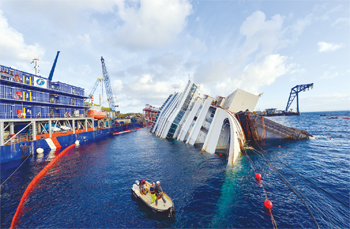The righting of the stricken cruise ship Costa Concordia was undertaken in the full glare of the world’s media throughout Monday 16 September. Crowley Maritime’s TITAN Salvage subsidiary and the Italian firm Micoperi were ready to get the process going early in the morning, and a live feed on the BBC website kept interested parties up to date with the salvage project, which is the biggest, most expensive and most complex of its kind ever.
The events of 16 September were the most significant in the salvaging of Costa Concordia since the work to remove the wreck began more than 18 months ago. The latest operation involved the rotation, or parbuckling, of the ship to an upright position. This began during the early hours of the day and was completed late on Monday night. The marathon operation lasted around 19 hours but was successfully executed. As the ship came clear of the water, the extent of the considerable damage to her hull became evident.
The wreck had already been stabilised using an anchoring system made up of four submarine anchor blocks fixed to the sea bottom between the centre of the wreck and the coast. Huge sponsons had been fixed to the side of the ship to ensure she floated. More sponsons will be attached to the other side of the ship, once the level of damage has been assessed, enabling her to be floated.
The Senior Salvage Master, Nick Sloane, gave the order to activate the commands from the control room located on the barge Pollux, which was moored in the immediate vicinity of the bow of Concordia.
TITAN Salvage and partner Micoperi, an Italian company specialising in underwater construction and engineering, will continue to work to refloat the wrecked ship, and, once she has been stabilised, she will be towed away to a port to be scrapped. Of the 3,229 passengers and 1,023 crew known to have been aboard at the time of the incident, 30 people died, and two passengers are missing.


